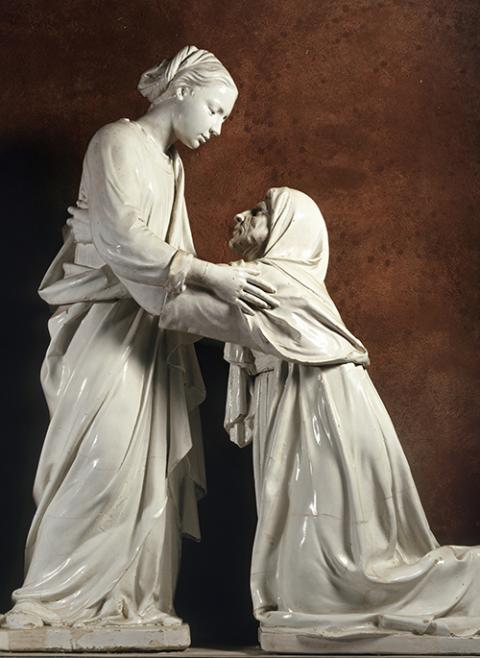
A depiction of Mary and Joseph's journey to Bethlehem sculpted from sand is displayed in the Italian resort town of Jesolo. (CNS/Jesolo Tourism Office)
I have been preoccupied with pregnancy recently, which is somewhat puzzling even to me. Perhaps it is for a few reasons: hearing reports from sisters working in maternity hospitals in different parts of the world, assisting women in their pregnancies and deliveries, and because we recently celebrated the feast of the Presentation of Mary in the temple, and because we are now in the season of Advent where Mary plays a significant and important role leading up to Christmas.
I have been pondering what those nine months would have been like for Mary following the Annunciation in March of her pregnancy. We have never heard much if anything about those experiences, perhaps because the Scriptures were written by men and either this woman's experience seemed insignificant or not relevant to their purposes. I wonder if women had written the Scriptures if they might have shared her stories. There may be some apocrypha that I am not aware of.
Now and then I have had friends spill bits and pieces of what they experienced in pregnancy but nothing in full detail. I decided to go online wondering if anyone had written about it. I found a study that features 12 women who kept diaries and shared them with the researchers. They were intriguing and informative. I also recall a book of poetry, Mary: A Life in Verse by Patricia Monaghan who captures some of the feelings that the women in the study describe from the discovery of pregnancy up to birth.
Responding to the discovery of pregnancy is clearly unique for each person. For most it is shock, often mixed with feelings of joy and/or anxiety and even fear, depending on the situations. For some, awareness of pregnancy came without any intention and for others, even with intention and hope for a child, it was a surprise. Women spoke of deep feelings of intense vulnerability and questioning about what the future would hold. Uncertainty was a strong emotion.

A young pregnant woman caresses her stomach in this 2013 file photo. (CNS/Enrique Cangas)
So, reading the women's stories, I did my own imagining of Mary. There was definitely no intentionality for her, so shock probably was paramount, not only for her, but for Joseph as well once he found out. Fear, confusion and anxiety come to mind, imagining the conversation she must have had with her fiancé. No matter if Joseph received the message from someone else first, they would have had to talk about it. Some of the women's diaries mentioned the anxiety they experienced in relating the news to their partners. Even when both partners desired a child, the reality of its beginning is not entirely a time of joy, but also uncertainty, thinking how their lives would be changed.
No doubt the experience of vulnerability or surrender to the new reality would not be easy emotional movements to endure, no matter how strong the faith of either Mary or Joseph. We only assume from the story given to us that she and Joseph were reconciled to their situation and trusted that God was somehow with them in it. The darkness of its consequences is not shared with us.
The consequences begin to emerge on their own, with or without consent. One woman related that she knew from her body reaction that she was pregnant before it was even confirmed so she had time to come to acceptance. Others told of their struggle to accept it.
Our bodies have ways of speaking to us about unforeseen impacts. For some of the women who became pregnant, the body first showed its resistance to the change through nausea or other physical reactions. Unpleasantness begins and increases as body changes take place. One woman in the study described growing awareness of her body automatically making space for this new creature taking life within her and from her, sharing her lifeblood and her feelings. Others described it as a kind of invasion that they had no control over, and another as a kind of invitation to giving oneself over to something that was happening to her. Each one described the variety of feelings that went with these changes.
Advertisement
One woman described her body stretching day by day, making a pathway for birthing as this new person grew within. That new life was even determining or influencing her eating habits. She found herself craving and eating things she had never even liked before or been attracted to. She found her body responding automatically to this visitor's needs and desires. Most of us have heard those stories about new appetites for spicy or sweet foods like ice cream or pickles. I wondered how Mary experienced these changes.
Women spoke about adjusting to unbalancing as their bodies were being reshaped by the new weight that caused physical tiredness and awkwardness, accompanied by psychological and emotional ups and downs.
Preoccupations with vivid dreams and memories of their own childhoods and the parenting they had experienced were common among the women. They told of needing to speak with someone who understood what was happening. For some, this conversation was only with their partners and for others, friends or family.

"The Visitation," a sculpture attributed to Master Heinrich of Constance, circa 1310-20; MetMuseum.org states that "the figures of Mary and Elizabeth are each inset with crystal-covered cavities through which images of their infants may originally have been seen." (Metropolitan Museum of Art)
This need for companionship was one part of Mary's story we learned about. She was instructed to go to her cousin Elizabeth, who was six months pregnant. The implication was that Elizabeth needed assistance, but it seems natural that Mary, at her young age of 15 or 16, also needed support. I have often wondered where her mother was. Did she know? Was she alive? So much is missing from this important event in Mary's story. Nevertheless, Mary journeyed to visit her cousin Elizabeth who had already gone through the initial moments of discovery and development and was experiencing her own unique responses as an older woman. She also had a husband who was struck dumb with the news. How much help could he be?
The Scriptures tell us that Mary went immediately, but we don't really know the time frames of this story written by men. We are not told who she spoke to first or about her intention to travel. Her mother? Joseph?
The initial encounter with Elizabeth in the Scriptures is described as a faith encounter, but there would have been a human encounter as well. When would Mary have first told Elizabeth what had happened to her, sharing her fear and anxiety? Both women's stories were crisis events, even trauma moments on the human level. The story leaves it to us to imagine what the encounter really entailed. But, we are told only of the joy of a faith recognition. This may have come within the three months Mary spent with Elizabeth and Zechariah. It is hard to believe it was the first reaction.
During those months, as well as assisting her cousin, this younger woman received needed empathy and instruction too. They were both women of faith and this helped them cope, but did not necessarily diminish the fears for either of them. We can hope that their companionship spawned a deep intimacy and compassion that would have lasted over many years.
We know Mary returned home, but to what? Loneliness? We don't know. She had to live in a family and community context that would probably not have looked compassionately on her situation. So, no doubt, in spite of faith, she experienced deep emotional conflicts.

"The Visitation," circa 1445, created by Luca della Robbia, is pictured. The Bible contains examples that highlight the value of life, including when Elizabeth and Mary, both miraculously pregnant, met at the Visitation. (CNS/Courtesy of National Gallery of Art)
As her young body grew, not only in size, but as a nesting place for the child's movement, her sleep would have been affected, as most of the women's diaries reported. The new life had its own rhythms and needs for stretching, moving and sleeping that caused discomfort and negative emotions at times.
Both mothers and fathers need to make plans about how to accommodate this new life. According to reports, even extended families and others are often involved, anticipating the child they are all waiting for. No doubt, much advice — wanted and unwanted — is given.
We can only surmise from the Jewish family culture that there was great anticipation of this new member, even though the beginnings were unusual and unplanned for. The whole family has to adjust to the reality of the situation. It is not only the individual who is going through the pregnancy. Pregnancy is a community event that requires hospitality.
As delivery of the baby approaches, some women in the study reported experiencing a kind of emotional separation from the baby, a growing realization of "the other" as an independent being. There was also a sense of loss, anxiety and fear about the process of letting go and what it would mean to be left, emptied.
In Mary's story, we are not told the delivery date but we are told about external circumstances that definitely interrupted any family plans for the delivery.
A national census required that Mary and Joseph travel, no doubt not desired, but feared. Fear about the upcoming delivery was common in the women's reports, fear of the pain and the possibilities of things going wrong. In Mary's story is a 15- or 16-year-old traveling on a donkey, near her due date, for miles through rough terrain and cold desert temperatures. The loneliness must have been painful and terrifying, even if she and Joseph were in a group. She had no mother with her, no cousin, just Joseph, probably hoping to find a midwife when the time arrived.
We never hear if their hopes were fulfilled. We know nothing about this young woman's birthing experience. From others' accounts, a baby's journey to the outside world is hard for both mother and baby. It is a messy, hard work and usually painful; a deep loneliness for each of the two persons involved.
Prior to the birthing, some women in the study shared how they fantasied how their babies would be able to move through the birthing channel, fearing the efforts needed, wondering if they could do it, but somehow trusting their bodies would know what to do. Today, there are classes that prepare women and for some, their partners as well, for these final moments that give encouragement and methods of pain management.
And finally, it is over and yet it is also a new beginning. Two lives and many others are changed dramatically as new transitions begin to create a new life together. Uncertainty, doubts and anxieties do not decrease with the new arrival.
Why do I think it is important to take time to reflect deeply on Mary's experience and that of pregnant women in general? Bringing new life into the world is truly a mystery, but it is also a very human experience that we often take for granted, do not appreciate, and in many ways try to control.
As I read the women's stories from the study and related them to Mary, I was inspired by the courage pregnancy takes, the strength and trust it requires of the women, and how little appreciation there is for this human experience that brings forth life for our society. I also realized more deeply the need for more awareness of community, hospitality and care to assist the new family.
I also hope that this effort on my part as a celibate imagination will inspire women who are becoming mothers or have gone through the process to reflect on how their human stories of pregnancy and birthing might shed light on that of Mary, Jesus' mother and also give them a deeper appreciation of how their willingness to take on these journeys is a gift of magnitude they share with us.








